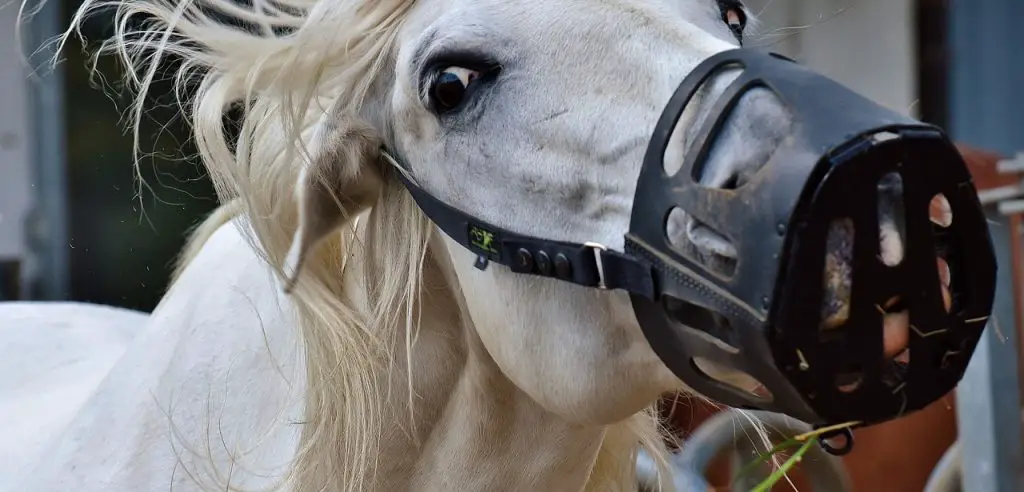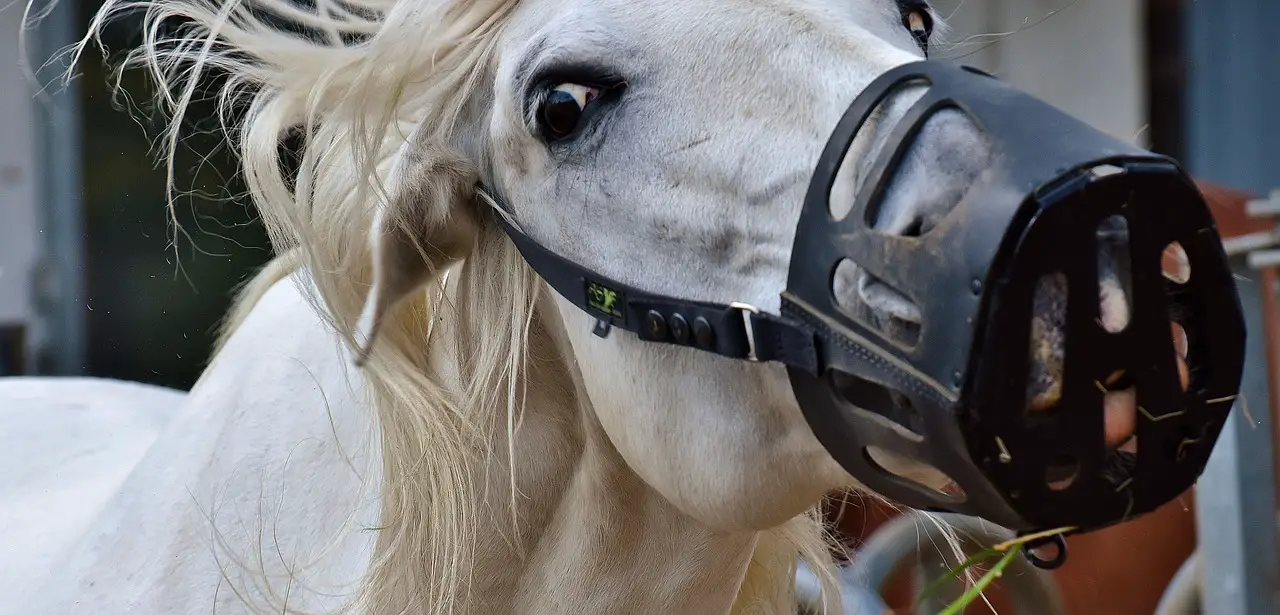Last Updated on March 8, 2024 by Allison Price
My horse is easy to keep and tends to be heavy. I worry about him becoming overweight. He is stalled overnight, and he receives grass hay with a low-starch balancer. He’s out on pasture during the day with other horses. He doesn’t have a dirt turnout, but I love the fact that he can be out during the day and socializes with other horses. Is it a good idea to use a grazing muzzle with my horse? How do I use it?
Bravo for taking control of your horse’s weight. It sounds like excessive grazing could lead to unwanted weight gain. Grazing muzzles are a great option in such situations. A grazing muzzle, when fitted properly, can help reduce grass intake but not stop horses from eating.
Horses can enjoy many benefits from pasture turnout, but there are also drawbacks. Turnout allows for greater movement. This is good for your gastrointestinal health and helps you burn calories. Turnout in groups allows horses to interact with each other in a way that is not possible in most stalls. Turnout in pasture can lead to excessive and often uncontrolled forage intakes, which can cause weight gain, as well as the associated health risks of Equine Metabolic Syndrome, insulin resistance, or laminitis in certain individuals.
Studies have shown that grazing muzzles were used on horses that had been stabled, but who were then left on pasture for 3 hours showed an 83% decrease in pasture intake . Some studies found a decrease of less than 80%. Horses that are not kept in stalls have a lot of advantages by being on pasture in groups.
A horse grazing muzzle can be a valuable tool that allows horses and ponies to enjoy the benefits of turnout, while limiting unwanted weight gain.
Fitting
It is important to fit a grazing mouthpiece correctly. There are many options available. Make sure you read the instructions on how to fit the brand that you choose. Be aware of areas where the muzzle might rub, such as the ears, bridge of your nose and points of the cheekbones. The muzzle should not touch the horse’s lips. The muzzle should be at least an inch away from your horse’s mouth. You should also make sure your horse is able to comfortably open his mouth when wearing the muzzle.
Introduction
It takes patience and a positive attitude to introduce the muzzle on horse. You can be sure that your horse will react negatively to the fact that you are about do something terrible to him, and that you feel guilty about it. Your horse’s temperament and personality will determine how he reacts.

Always begin slowly. Use the pressure and release principles (negative reinforcement and positive reinforcement) to place the muzzle beside your horse’s head. When he is comfortable, remove it. Continue this process until your horse is completely relaxed. Next, place the muzzle on his nose. After a few seconds, remove the muzzle again and reward calm behavior. Gradually increase how long the muzzle stays over the nose, and finally secure it for a brief period. I love to reward horses by giving them treats through their muzzle. This shows that the horse can eat with the muzzle off, but other rewards are also good.
Your horse should be able to hand-graze in the muzzle. The height of the grass is an important component to grazing the muzzle successfully. Too short grass won’t reach the muzzle sufficiently to allow horses to eat it. This can frustrate and annoy some horses. Because it bends over and doesn’t easily pass through the holes in your muzzle, too long grass can be difficult to eat. Before you turn a muzzled horse out on pasture grass, consider how long it is.
Safety
You can consider turning your horse out on his own after he has been happily and safely hand-grazing under the muzzle for a prolonged period of time. You should inspect the pasture for any areas where the muzzle could get caught. Fence off any areas that might be dangerous. The length of time you leave the muzzle on will vary depending on the situation. However, it should not be left on for more than 10 to 12 hours.
Remember that horses can indulge in compensatory eating once they are removed from their pasture. Horses can eat large quantities of their daily forage intake within a short time. If your horse is a binge eater, it might be worth removing the muzzle from pasture while the muzzle is still in place.
You should monitor your horse’s behavior, and notify you if there are any unusual changes. Keep track of your horse’s body weight and condition to ensure that you can adjust pasture access and feed as needed.
Take-Home Message
A grazing muzzle is a powerful tool for managing horses that are overweight in pasture. He might find it his ticket to more free-roaming and social interaction with his horses.


